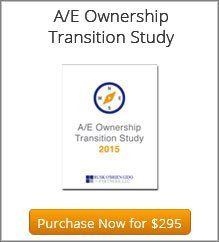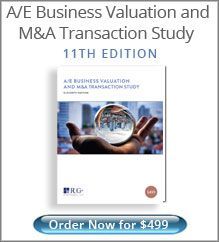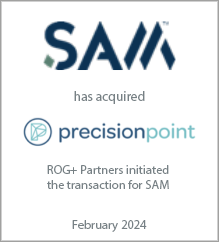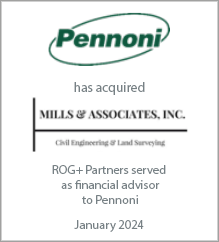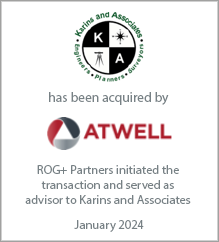Ian has spent the past twenty years working with hundreds of architecture, engineering and environmental consulting firms large and small throughout the U.S. and abroad with a focus on ownership planning, business valuation, ESOP advisory services, mergers & acquisitions, and strategic planning. Ian is a professionally trained and accredited business appraiser and holds the Accredited Senior Appraiser (ASA) designation with the American Society of Appraisers and is a certified merger & acquisition advisor (CM&AA) with the Alliance of Merger & Acquisition Advisors.
The Case Against Aggressive Financial Leverage in A/E Firms
The Case Against Aggressive Financial Leverage in A/E FirmsNew Paragraph
August 3, 2011
I’ve noticed that some industry experts have recently been advancing the idea that A/E firms are under-leveraged—suggesting that firm owners should consider borrowing more from banks and other lenders because debt is a cheaper source of capital. The other logic cited is that utilizing debt capital allows an owner to finance growth without diluting their own equity interest.
My personal opinion is that this is misguided advice (at least for all but the largest most stable firms in the industry) and fails to take into account some basic characteristics of the A/E industry.
It’s true that debt is often cheaper than equity capital, and the associated interest expense is tax deductible (for now anyway). But over-leverage your A/E firm and you’re begging for trouble. Earnings can be very volatile in this industry, and professional service firms typically have very little in hard assets to collateralize a business loan. In fact, many owners must personally guarantee even the modest credit facilities they already maintain. It’s one thing to fail to make a profit distribution to your fellow owners. But default on your bank loan payments or bust a loan covenant, and you’ll be in a world of hurt.
Even moderate debt levels can become problematic when a firm is hit with an unexpected downturn or faces collections issues with its clients. Cubellis, once an extremely successful and fast-growing architecture firm, is such an example. “Speaking from first-hand experience,” says Len Cubellis “while growing my A/E firm I always felt that my leverage was safe at 70% of my receivables under 90 days. Then the world turned upside down with the Lehman Brothers collapse. Once you’re outside your loan covenants, managing your firm’s finances is no longer within your control. The bank steps in and takes steps that protect their interests first.”
There are many examples of A/E firms that had to shut their doors over the last two years ONLY because they found themselves in default with their lenders after the recession caused their revenue and earnings levels to decline. These were very good firms with solid reputations, great people, great portfolios, etc. If these firms had been capitalized less with debt and more with equity, many would still be around.
So how much debt is appropriate? Some industry statistics might be helpful here. According to a 2010 study conducted by the accounting firm DiCicco, Gulman & Company, the median total liabilities-to-equity ratio for the industry is 1.24. Other studies, such as those by the industry research and publishing firm PSMJ Resources, put this ratio at a median of 0.9. When only bank debt is included, the ratio falls to just 0.2.
There are a number of reasons for the modest levels of debt that most A/E firms operate under. To begin with, A/E firms are not capital-intensive. Without large amounts of fixed assets, there’s less need to borrow and, as previously stated, less tangible assets to use as collateral.
Earnings volatility is another factor. A/E firms, particularly smaller ones, often have highly volatile earnings levels. This is the nature of the project-based professional service industry we operate in. Debt is not a wise source of capital in a firm with volatile and unpredictable earnings due to the aforementioned default risk.
Finally, the ownership structure of most A/E firms must be considered. The vast majority of firms in the industry are owned by a small number of senior managers. In most cases, these owners must personally guarantee their company’s debt. It’s no surprise, therefore, to see these owners exhibit conservative borrowing patterns.
To grow and sustain your A/E firm you need to be willing to provide opportunities for ownership to key people. Don’t try to finance your growth by taking on debt out of a fear of diluting your equity. Apply such a strategy, and the following is likely to happen: The most talented folks you have will leave; you’ll fail to attract new talent; and you’ll ultimately be left with a 100% equity stake in nothing (or worse, you’ll owe more to the bank than your company is worth).
By contrast, if you adopt the opposite strategy and “share the wealth” you’re more likely to be rewarded with the loyalty of high-quality employees as well as the ability to attract top talent. Most owners I know would rather have a smaller equity stake in an investment of real and growing value than a 100% equity stake in a stagnant, over-leveraged business.
We’re interested to hear your thoughts on this subject, to voice your opinion, join our LinkedIn group or email me at irusk@rog-partners.com.
My personal opinion is that this is misguided advice (at least for all but the largest most stable firms in the industry) and fails to take into account some basic characteristics of the A/E industry.
It’s true that debt is often cheaper than equity capital, and the associated interest expense is tax deductible (for now anyway). But over-leverage your A/E firm and you’re begging for trouble. Earnings can be very volatile in this industry, and professional service firms typically have very little in hard assets to collateralize a business loan. In fact, many owners must personally guarantee even the modest credit facilities they already maintain. It’s one thing to fail to make a profit distribution to your fellow owners. But default on your bank loan payments or bust a loan covenant, and you’ll be in a world of hurt.
Even moderate debt levels can become problematic when a firm is hit with an unexpected downturn or faces collections issues with its clients. Cubellis, once an extremely successful and fast-growing architecture firm, is such an example. “Speaking from first-hand experience,” says Len Cubellis “while growing my A/E firm I always felt that my leverage was safe at 70% of my receivables under 90 days. Then the world turned upside down with the Lehman Brothers collapse. Once you’re outside your loan covenants, managing your firm’s finances is no longer within your control. The bank steps in and takes steps that protect their interests first.”
There are many examples of A/E firms that had to shut their doors over the last two years ONLY because they found themselves in default with their lenders after the recession caused their revenue and earnings levels to decline. These were very good firms with solid reputations, great people, great portfolios, etc. If these firms had been capitalized less with debt and more with equity, many would still be around.
So how much debt is appropriate? Some industry statistics might be helpful here. According to a 2010 study conducted by the accounting firm DiCicco, Gulman & Company, the median total liabilities-to-equity ratio for the industry is 1.24. Other studies, such as those by the industry research and publishing firm PSMJ Resources, put this ratio at a median of 0.9. When only bank debt is included, the ratio falls to just 0.2.
There are a number of reasons for the modest levels of debt that most A/E firms operate under. To begin with, A/E firms are not capital-intensive. Without large amounts of fixed assets, there’s less need to borrow and, as previously stated, less tangible assets to use as collateral.
Earnings volatility is another factor. A/E firms, particularly smaller ones, often have highly volatile earnings levels. This is the nature of the project-based professional service industry we operate in. Debt is not a wise source of capital in a firm with volatile and unpredictable earnings due to the aforementioned default risk.
Finally, the ownership structure of most A/E firms must be considered. The vast majority of firms in the industry are owned by a small number of senior managers. In most cases, these owners must personally guarantee their company’s debt. It’s no surprise, therefore, to see these owners exhibit conservative borrowing patterns.
To grow and sustain your A/E firm you need to be willing to provide opportunities for ownership to key people. Don’t try to finance your growth by taking on debt out of a fear of diluting your equity. Apply such a strategy, and the following is likely to happen: The most talented folks you have will leave; you’ll fail to attract new talent; and you’ll ultimately be left with a 100% equity stake in nothing (or worse, you’ll owe more to the bank than your company is worth).
By contrast, if you adopt the opposite strategy and “share the wealth” you’re more likely to be rewarded with the loyalty of high-quality employees as well as the ability to attract top talent. Most owners I know would rather have a smaller equity stake in an investment of real and growing value than a 100% equity stake in a stagnant, over-leveraged business.
We’re interested to hear your thoughts on this subject, to voice your opinion, join our LinkedIn group or email me at irusk@rog-partners.com.
Latest Perspective
Perfecting the A/E Exit Strategy – Five Key Factors
An enormous A/E generation that kicked off their careers in the 1980s and subsequently started firms or became owners in the 1990s ...
© 2024
Rusk O'Brien Gido + Partners, LLC
Financial Experts for Architects, Engineers, and Environmental Consulting Firms




